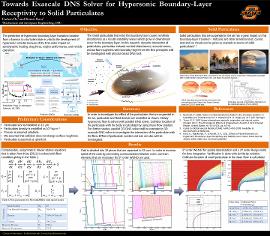| dc.contributor.author | Oz, Furkan | |
| dc.contributor.author | Kara, Kursat | |
| dc.contributor.other | Coalition for Advancing Digital Research and Education (2020) | |
| dc.date.accessioned | 2020-06-03T19:56:22Z | |
| dc.date.available | 2020-06-03T19:56:22Z | |
| dc.date.issued | 2020-04-17 | |
| dc.identifier | oksd_cadre_2020_oz | |
| dc.identifier.citation | Oz, F., & Kara, K. (2020, April 17). Towards exascale DNS solver for hypersonic boundary-layer receptivity to solid particulates. Poster presented at the fourth annual Coalition for Advancing Digital Research and Education (CADRE) Conference, Stillwater, OK. | |
| dc.identifier.uri | https://hdl.handle.net/11244/324829 | |
| dc.description.abstract | Development in hypersonic vehicles is dependent on the prediction of hypersonic boundary-layer transition location from a laminar to turbulent state because aerodynamic heating, drag force, engine performance, and vehicle operation are highly affected by the boundary-layer transition. To make precise prediction about boundary-layer transition points, it is required to understand the fundamental physics behind it. Although some key mechanisms are enlightened with recent studies, there are still unsolved part of this complex physics. Process of transformation of external disturbances into instability waves which grow in the downstream and causes to turbulence is called as receptivity. Small solid particles suspended in the atmosphere may be a significant source of boundary-layer instabilities. Their sizes in micro scales. Since particulate sizes are very small, fine meshes are used to catch the small disturbances that is induced by these small particulates and this makes parallelizing the solver inevitable. For more complex cases, heterogonous and exascale computing is required to obtain the results in a practical time period. In this poster, progress towards a physics-based parallel direct numerical simulation (DNS) tool to simulate the dynamic interaction of particulates, particulate-induced vortical disturbances, acoustic waves, and surface roughness with boundary-layer from the first principles will be presented. | |
| dc.format | application/pdf | |
| dc.language | en_US | |
| dc.publisher | Oklahoma State University | |
| dc.rights | In the Oklahoma State University Library's institutional repository this paper is made available through the open access principles and the terms of agreement/consent between the author(s) and the publisher. The permission policy on the use, reproduction or distribution of the article falls under fair use for educational, scholarship, and research purposes. Contact Digital Resources and Discovery Services at lib-dls@okstate.edu or 405-744-9161 for further information. | |
| dc.title | Towards exascale DNS solver for hypersonic boundary-layer receptivity to solid particulates | |
| osu.filename | oksd_cadre_2020_oz.pdf | |
| dc.description.department | Mechanical and Aerospace Engineering | |
| dc.type.genre | Conference proceedings | |
| dc.type.material | Text | |
| dc.subject.keywords | hypersonic flow | |
| dc.subject.keywords | direct numerical simulation (dns) | |
| dc.subject.keywords | small particulates | |
| dc.subject.keywords | receptivity | |
| dc.subject.keywords | disturbance | |
| dc.subject.keywords | boundary layer | |
| dc.subject.keywords | laminar to turbulent transition | |
